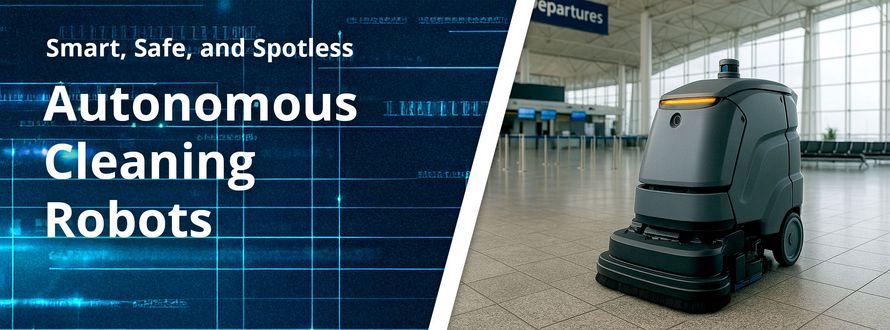In a world that demands higher cleanliness standards, operational efficiency, and sometimes even contactless solutions, autonomous cleaning robots have emerged as powerful allies across a broad range of industries and use cases. Originally gaining traction in airports and hospitals, these intelligent machines are now transforming shopping malls, warehouses, manufacturing plants, hotels, and even public transportation hubs.
As their roles expand, so do the technological and regulatory demands placed upon them. Ensuring these robots are safe, reliable, and adaptable requires not just advanced hardware, but robust, real-time embedded software. That’s where solutions like SYSGO’s PikeOS step in—enabling the next generation of intelligent, secure, and certifiable autonomous cleaning systems.
Expanding Use Cases across Industries
1. Airports
Autonomous robots are used to clean vast terminal floors, restrooms, and waiting areas. These robots may operate during peak hours or continuously in traffic zones. They use sensors, cameras, and AI for navigation and dirt detection, optimizing cleaning paths and adapting to changing environments.
2. Hospitals
Hospitals benefit from autonomous disinfection robots equipped with UV-C lights and advanced air filtration systems. These robots reduce pathogen spread and free up staff for more critical healthcare tasks.
3. Shopping Centers and Supermarkets
Retail environments use cleaning robots during and after hours to clean floors, sanitize high-touch areas like cart handles, and provide visible reassurance to customers that hygiene is prioritized.
4. Industrial Warehouses and Manufacturing
In environments where dust, oil, or debris can become safety hazards, robots help maintain cleanliness while reducing downtime. Some units even adapt to industry-specific contaminants like metal shavings or chemical residues.
5. Public Transport and Stations
Subway stations, train platforms, and buses are now being cleaned with robotic systems, especially during late-night hours. These machines work efficiently in tight spaces and mixed traffic environments, including near passengers or maintenance crews.
Key Trends in autonomous Cleaning Robotics
- AI-Driven Navigation: Robots now use AI and machine learning for dynamic path planning, obstacle avoidance, and operational optimization. When a human obstructs the robot’s path, onboard sensors and vision systems detect the presence, prompting the robot to stop, re-route, or issue polite audio notifications to inform the person of its intent to continue. This enhances safety and improves human-robot interaction in public spaces.
- Multi-Functionality: Robots that can vacuum, mop, scrub, and disinfect simultaneously are becoming the norm.
- Fleet Management: Centralized platforms manage multiple robots across large facilities, optimizing workflows and reporting.
- Human-Robot Collaboration: Robots are increasingly designed to coexist safely with humans, with enhanced perception systems and behavior prediction. Verbal cues or sound signals are now common features to alert nearby individuals of the robot’s actions or if assistance is required.
Challenges in widespread Deployment
Despite rapid progress, autonomous cleaning robots face several challenges:
1. Safety-critical Operation
Cleaning robots, especially in hospitals or near production lines, must adhere to strict safety regulations. Faults in software could cause physical harm or disrupt operations.
2. Cybersecurity Risks
As robots connect to building systems and the cloud, they can become targets for cyberattacks. Unprotected endpoints can lead to system-wide vulnerabilities.
3. Software Complexity
These robots rely on multiple subsystems: Perception (LiDAR, cameras), locomotion, task scheduling, remote connectivity, and user interfaces. Managing these systems requires advanced partitioning and robust real-time control.
4. Certification Requirements
Certain environments—like healthcare or industrial facilities—require systems to be certifiable according to safety standards (e.g., ISO 26262 (automotive), IEC 61508 (industrial automation), or ISO 13849 (machinery control)). This is difficult to achieve without purpose-built software platforms.
The Role of SYSGO: Enabling secure, safe, and real-time robotic Operations
SYSGO offers cutting-edge solutions for embedded systems that directly address the needs of autonomous cleaning robot developers:
PikeOS: The certifiable RTOS & Hypervisor
PikeOS is more than just an RTOS (real-time operating system)—it is a separation kernel-based system that supports mixed-criticality workloads, real-time guarantees, and safety / security certification. Its capabilities align perfectly with the demands of autonomous cleaning robots.
Key Benefits:
- Safe Partitioning of Functions
Using PikeOS, developers can isolate navigation, cleaning logic, user interfaces, and connectivity into separate partitions. This architecture enables fault containment, making systems more robust and easier to update or certify. - Real-Time Performance
Cleaning robots must react instantly to environmental inputs. PikeOS ensures deterministic behavior, essential for responsive navigation and dynamic path planning. - Security by Design
With built-in support for Common Criteria EAL certifications and secure boot, PikeOS guards against unauthorized access and malware. This is critical for robots connected to the cloud or remote management systems. - Multi-OS Support
PikeOS supports POSIX, ARINC 653, AUTOSAR, and other RTEs / APIs, enabling developers to run legacy code alongside new components. - Certifiable Foundation
PikeOS is ready for use in applications that need compliance with safety standards across industries: Aerospace (DO-178C), industrial automation (IEC 61508), rail (EN 50128), automotive (ISO 26262) and medical (IEC 62304).
Future Outlook
Autonomous cleaning robots are rapidly moving from novelty to necessity. As environments become more hygiene-conscious and staff availability remains limited, robots will continue to fill the gap with enhanced autonomy, intelligence, and efficiency.
In the future, we can expect:
- Greater Autonomy: With continual improvements in AI and sensor fusion.
- Interconnected Ecosystems: Integration into smart building systems and predictive maintenance platforms.
- Higher Safety Standards: Including formal verification and real-time certifications, especially in medical and high-risk industrial environments.
SYSGO, with its proven expertise in safety- and security-critical embedded systems, is well-positioned to support this evolution. By enabling robots to operate securely, efficiently, and reliably—even in the most demanding settings—SYSGO is helping shape a cleaner, safer, and smarter world.
Conclusion
Autonomous cleaning robots are redefining cleanliness and efficiency across industries—from airports to hospitals, malls to factories. But behind their sleek design and quiet operation lies complex, mission-critical software.
SYSGO’s PikeOS offers the foundational platform needed to meet the industry’s growing demands for safety, security, and performance. As the robotic workforce expands, it's embedded platforms like PikeOS that will ensure these machines not only clean effectively but do so with unwavering reliability.
The future is spotless—and it’s powered by smart software.

